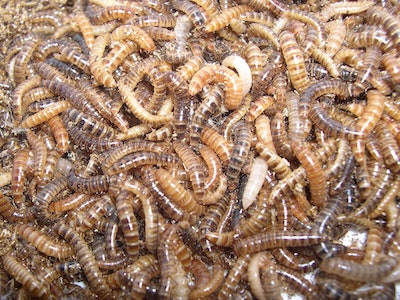
The financial impact that darkling beetles have on broiler production is currently unknown. This is because darkling beetle infestations have a wide range of implications for producers that are near impossible to quantify.
“There are at least one million darkling beetles, including the pupae, in every broiler house and there is currently no way to completely eradicate them,” said Nancy Hinkle, a University of Georgia (UGA) entomology professor.
According to Hinkle, a research study to determine the economic impact of darkling beetles on poultry production would be extremely challenging, if not impossible. No two broiler houses or flocks are the same, making the economic impact of darkling beetles on each house different. However, finding out the impact is highly desirable, explained Hinkle.
To attempt the challenge, Hinkle partnered with the University of Delaware and conducted a study to investigate the cost of darkling beetles on a producer’s bottom line. While a financial value was not assigned in the study, Hinkle said the research is a step in the right direction.
Defining how much damage a darkling beetle population can cause, and then converting that into dollars, is an important step in determining what management expenses can be financially justified for producers.
Salmonella
“Even if we could completely eradicate darkling beetles in one house and populate them in another, the darkling beetles would not be the only thing impacting the economic success of that flock. Not to mention the food safety impact that darkling beetles have due to carrying Salmonella,” stated Hinkle.
Darkling beetles serve as an intermediate host and vector of several pathogens and parasites that affect the birds, such as Salmonella.
“Not only can Salmonella be carried in darkling beetles, but Salmonella can reproduce in them, so they are perpetuating the infection and increasing the risk of transmission to other birds and humans,” she said.
Because darkling beetles have an indigestible exoskeleton, they remain inside a broiler’s gut and decrease the amount of feed a bird can consume, which in turn decreases nutrition and reduces weight gain.
“Anything that reduces weight gain in broilers causes economic loss,” she added.
Structural damage
One of the biggest problems is when the larvae get ready to pupate, or develop from larvae into adult darkling beetles, they create a pupal chamber in the habitat. Hinkle said this habitat could be under the caked portions of the litter or in the cracks and crevices of the walls of the poultry house.
Unfortunately, in producing these pupal chambers, darkling beetles frequently climb up into the attic and burrow in the insulation. If present, mice or other critters will often go find the pupae and eat them. This means the holes that the pupae are burrowed in are enlarged, impacting the structural integrity of the insulation even further.
Before paying to replace the insulation, producers will have to use more energy to warm or cool the poultry house, which costs additional money, explained Hinkle. If poultry houses are located in extremely hot or cold areas, producers will spend even more to counteract the insulation damage.
“Within two or three years, you can really have significant economic damage done to these insulating materials by darkling beetles and mice,” stated Hinkle.
Insecticide rotation
“We have not found many management techniques that can sufficiently impact darkling beetle populations. They can tolerate very wide temperature ranges and dry or moist conditions,” said Hinkle.
While Hinkle believes the industry should use insecticides to control darkling beetles, she stressed that insecticide resistance is prevalent globally and that many pyrethroids and organophosphates previously used by producers are not very effective anymore.
Specifically, Danny McDonald, Ph.D., Control Solutions Inc. tech services manager, recommends that producers rotate between insecticide classes because it slows and prevents the development of pest resistance by switching between modes of action, or how the active ingredient kills its target organism.
“I encourage rotating both neurotoxin classes and insect growth regulator classes. There are only four neurotoxin classes available in animal production: pyrethroids, neonicotinoids, organophosphates and spinosyns. Additionally, there are only two classes of insect growth regulators (IGR): juvenile hormone mimics and chitin synthesis inhibitors,” said McDonald.
“We recommend switching between classes within each of these categories every six months. Always pair one of the neurotoxin classes with one of the insect growth regulator classes,” McDonald stated.
To address darkling beetles with insecticides, Frank Jusich, Pertinent Eco-Solutions head of commercial operations, suggests that producers use Pertinent Ag Crawling Insect Concentrate because it can be used while birds are in the house.
Because darkling beetles tend to live deep in litter and come out when birds feed or water, products approved to be used around feeders and birds are needed. In addition, producers should decake the litter before applying to ensure it will effectively penetrate the surface.
Other strategies
While insecticide rotation is the primary method for addressing darkling beetles, Alissa Welsher, Ph.D., Elanco food safety technical advisor, suggests that producers consistently clean-out manure, cut the grass or weeds around buildings and maintain proper ventilation to help control the moisture.
Specifically, Welsher recommended the Elanco Beetle Evaluation Form, which is a qualitative assessment tool that requires producers to evaluate six different locations throughout a house and search for beetles by creating small trenches.
Welsher says it is best to conduct the initial evaluation just before a flock exits the house, when the beetle numbers will be highest and again seven days after a new flock arrives.
The environment in modern poultry barns offers ideal conditions for darkling beetles, and eliminating anything that is conducive to them is important, explained Anna Hansen, MGK Technical Services support specialist. This includes removing any spilled feed, picking up dead birds daily, cleaning out litter between flocks or windrowing the litter to reduce the microbial load.


















